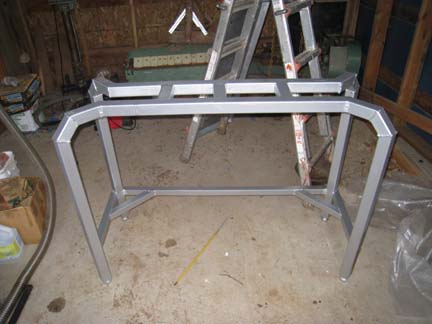Creating a Metal Lathe StandOpalyn hones her welding skillsLast summer I began acquiring welding skills and with the help of Jim Mason and Walt, I welded together my very own GEK (Gasification Experimenters Kit). Wanting to improve my skills, I enrolled in a welding class that met once a week at the high school welding lab in The Dalles. Throughout the fall my skills steadily improved and I decided to build a stand for a piece of equipment that has been tucked away in deep storage. We pulled the 10"x24" metal lathe out of storage and brought it down to the Artisan’s Workshop. Using the bolt pattern and the lathe's overall dimensions, I designed and cut 2” box tubing to create a heavy-duty stand.
The design called for 22 pieces of steel, four bolts, and four nuts. Most of the angles are 45° which provided a unique learning opportunity. For the most part only two pieces matched exactly, while another pair were complimentary. The most interesting feature is the adjustable legs, a trick I picked up from Walt.
I worked steadily throughout the fall and finished the stand in early December, and brought it home to the Artisan’s Workshop a couple days ahead of the huge snow storm that shut everything down as far away as Portland for weeks. In February, with a few days of warmer weather between the snow storms, I cleaned up the stand and gave it a coat of Rustoleum Aluminum-colored Paint. A few days later, I laid out the bolt holes and started drilling. The holes needed to be a half-inch in diameter; since that's a lot of metal to chew through, I started with a small drill bit and drilled six pilot holes through the top of the metal tubes. Then I switched to a slightly larger bit that was long enough to drill through both sides of the box tubing. After that it was just a matter of drilling a series of slightly larger holes until I reached the final size.
With the holes completed, the next step was a visit to the hardware store for the necessary bolts and nylocks. Camille took a tractor-size inner tube from our re-use stock and made a series of rubber washers that we installed in between the lathe and it's pan. A water-tight pan under the lathe will allow us to use and reuse cutting fluid in order to keep the tools cool and sharp. Being a novice metal worker, seeing the serious tools come out of storage and get set up for use, I feel like a kid on Christmas morning. |


